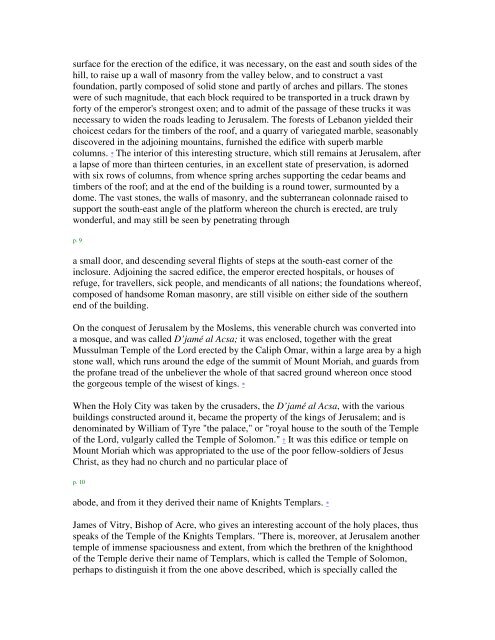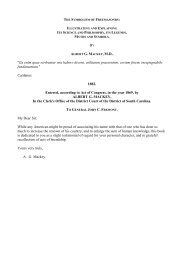The History of the Knights Templar by Charles G ... - Masonic Renewal
The History of the Knights Templar by Charles G ... - Masonic Renewal
The History of the Knights Templar by Charles G ... - Masonic Renewal
Create successful ePaper yourself
Turn your PDF publications into a flip-book with our unique Google optimized e-Paper software.
surface for <strong>the</strong> erection <strong>of</strong> <strong>the</strong> edifice, it was necessary, on <strong>the</strong> east and south sides <strong>of</strong> <strong>the</strong><br />
hill, to raise up a wall <strong>of</strong> masonry from <strong>the</strong> valley below, and to construct a vast<br />
foundation, partly composed <strong>of</strong> solid stone and partly <strong>of</strong> arches and pillars. <strong>The</strong> stones<br />
were <strong>of</strong> such magnitude, that each block required to be transported in a truck drawn <strong>by</strong><br />
forty <strong>of</strong> <strong>the</strong> emperor's strongest oxen; and to admit <strong>of</strong> <strong>the</strong> passage <strong>of</strong> <strong>the</strong>se trucks it was<br />
necessary to widen <strong>the</strong> roads leading to Jerusalem. <strong>The</strong> forests <strong>of</strong> Lebanon yielded <strong>the</strong>ir<br />
choicest cedars for <strong>the</strong> timbers <strong>of</strong> <strong>the</strong> ro<strong>of</strong>, and a quarry <strong>of</strong> variegated marble, seasonably<br />
discovered in <strong>the</strong> adjoining mountains, furnished <strong>the</strong> edifice with superb marble<br />
columns. * <strong>The</strong> interior <strong>of</strong> this interesting structure, which still remains at Jerusalem, after<br />
a lapse <strong>of</strong> more than thirteen centuries, in an excellent state <strong>of</strong> preservation, is adorned<br />
with six rows <strong>of</strong> columns, from whence spring arches supporting <strong>the</strong> cedar beams and<br />
timbers <strong>of</strong> <strong>the</strong> ro<strong>of</strong>; and at <strong>the</strong> end <strong>of</strong> <strong>the</strong> building is a round tower, surmounted <strong>by</strong> a<br />
dome. <strong>The</strong> vast stones, <strong>the</strong> walls <strong>of</strong> masonry, and <strong>the</strong> subterranean colonnade raised to<br />
support <strong>the</strong> south-east angle <strong>of</strong> <strong>the</strong> platform whereon <strong>the</strong> church is erected, are truly<br />
wonderful, and may still be seen <strong>by</strong> penetrating through<br />
p. 9<br />
a small door, and descending several flights <strong>of</strong> steps at <strong>the</strong> south-east corner <strong>of</strong> <strong>the</strong><br />
inclosure. Adjoining <strong>the</strong> sacred edifice, <strong>the</strong> emperor erected hospitals, or houses <strong>of</strong><br />
refuge, for travellers, sick people, and mendicants <strong>of</strong> all nations; <strong>the</strong> foundations where<strong>of</strong>,<br />
composed <strong>of</strong> handsome Roman masonry, are still visible on ei<strong>the</strong>r side <strong>of</strong> <strong>the</strong> sou<strong>the</strong>rn<br />
end <strong>of</strong> <strong>the</strong> building.<br />
On <strong>the</strong> conquest <strong>of</strong> Jerusalem <strong>by</strong> <strong>the</strong> Moslems, this venerable church was converted into<br />
a mosque, and was called D’jamé al Acsa; it was enclosed, toge<strong>the</strong>r with <strong>the</strong> great<br />
Mussulman Temple <strong>of</strong> <strong>the</strong> Lord erected <strong>by</strong> <strong>the</strong> Caliph Omar, within a large area <strong>by</strong> a high<br />
stone wall, which runs around <strong>the</strong> edge <strong>of</strong> <strong>the</strong> summit <strong>of</strong> Mount Moriah, and guards from<br />
<strong>the</strong> pr<strong>of</strong>ane tread <strong>of</strong> <strong>the</strong> unbeliever <strong>the</strong> whole <strong>of</strong> that sacred ground whereon once stood<br />
<strong>the</strong> gorgeous temple <strong>of</strong> <strong>the</strong> wisest <strong>of</strong> kings. *<br />
When <strong>the</strong> Holy City was taken <strong>by</strong> <strong>the</strong> crusaders, <strong>the</strong> D’jamé al Acsa, with <strong>the</strong> various<br />
buildings constructed around it, became <strong>the</strong> property <strong>of</strong> <strong>the</strong> kings <strong>of</strong> Jerusalem; and is<br />
denominated <strong>by</strong> William <strong>of</strong> Tyre "<strong>the</strong> palace," or "royal house to <strong>the</strong> south <strong>of</strong> <strong>the</strong> Temple<br />
<strong>of</strong> <strong>the</strong> Lord, vulgarly called <strong>the</strong> Temple <strong>of</strong> Solomon." † It was this edifice or temple on<br />
Mount Moriah which was appropriated to <strong>the</strong> use <strong>of</strong> <strong>the</strong> poor fellow-soldiers <strong>of</strong> Jesus<br />
Christ, as <strong>the</strong>y had no church and no particular place <strong>of</strong><br />
p. 10<br />
abode, and from it <strong>the</strong>y derived <strong>the</strong>ir name <strong>of</strong> <strong>Knights</strong> <strong>Templar</strong>s. *<br />
James <strong>of</strong> Vitry, Bishop <strong>of</strong> Acre, who gives an interesting account <strong>of</strong> <strong>the</strong> holy places, thus<br />
speaks <strong>of</strong> <strong>the</strong> Temple <strong>of</strong> <strong>the</strong> <strong>Knights</strong> <strong>Templar</strong>s. "<strong>The</strong>re is, moreover, at Jerusalem ano<strong>the</strong>r<br />
temple <strong>of</strong> immense spaciousness and extent, from which <strong>the</strong> brethren <strong>of</strong> <strong>the</strong> knighthood<br />
<strong>of</strong> <strong>the</strong> Temple derive <strong>the</strong>ir name <strong>of</strong> <strong>Templar</strong>s, which is called <strong>the</strong> Temple <strong>of</strong> Solomon,<br />
perhaps to distinguish it from <strong>the</strong> one above described, which is specially called <strong>the</strong>



